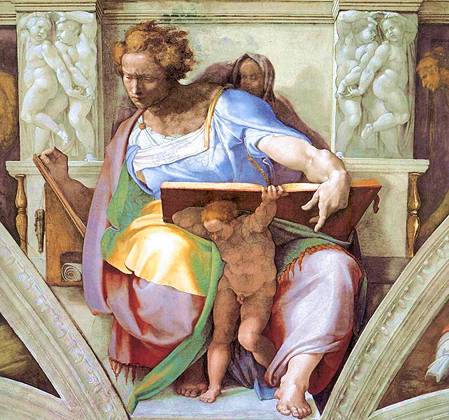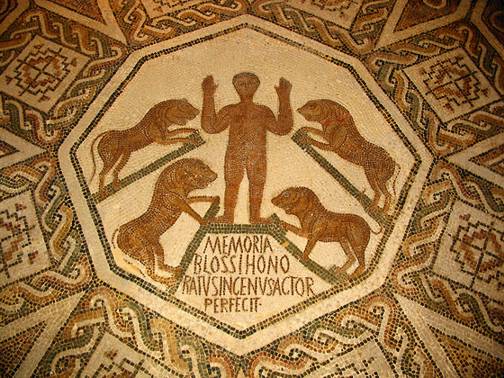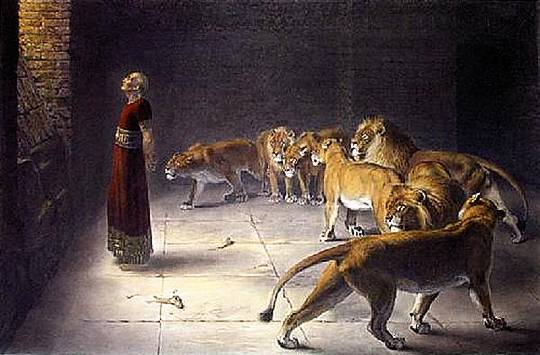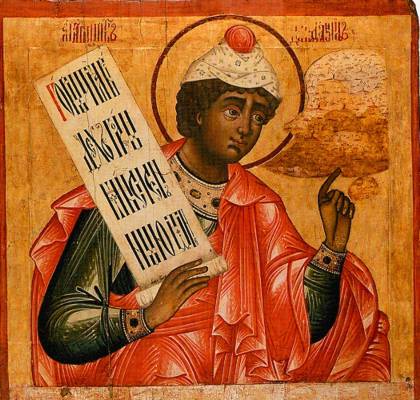Lessico
Daniele

Il
profeta Daniele
Affresco di Michelangelo Buonarroti
all'interno della Cappella Sistina in Vaticano
Profeta ebraico (sec. VII-VI aC). Originario della tribù di Giuda, fu deportato a Babilonia nel 605 aC. Per i suoi doni profetici fu interprete dei sogni alla corte di Nabucodonosor II. Il Libro di Daniele è l'ultimo libro dei profeti maggiori nella Bibbia cattolica, incluso invece fra gli agiografici in quella ebraica. Parte dell'opera è scritta in aramaico (2,4b-7,28), il resto in ebraico. Il genere letterario è quello apocalittico, ravvivato da formule simboliche. Descrive la venuta del Regno di Dio accompagnata da fenomeni cosmici e terreni terrificanti, con forti componenti mitiche.
Il libro è anonimo o
pseudonimo. I primi sei capitoli narrano la deportazione di Daniele a
Babilonia, la sua educazione a corte, la sua fedeltà alla legge ebraica e la
sua arte interpretativa dei sogni. Nella seconda parte si descrivono una serie
di azioni simboliche apocalittiche, tutte collegate ad avvenimenti della prima
metà del sec. II aC, specialmente in relazione alle persecuzioni ordinate da
Antioco IV Epifane![]() e alle guerre maccabee. Il
carattere leggendario della prima parte e la relativa esattezza della seconda
rendono probabile una composizione del libro nel sec. II aC, sia pure
utilizzando materiali tradizionali, per rafforzare la comunità israelitica
palestinese ai tempi della persecuzione.
e alle guerre maccabee. Il
carattere leggendario della prima parte e la relativa esattezza della seconda
rendono probabile una composizione del libro nel sec. II aC, sia pure
utilizzando materiali tradizionali, per rafforzare la comunità israelitica
palestinese ai tempi della persecuzione.
Daniele

Mosaico
romano cristiano del IV sec detto di Daniele tra i leoni
Museo nazionale del Bardo - Tunisi
Daniele è uno dei profeti della Bibbia. Il Libro di Daniele che gli è attribuito è presente tra i Ketuvim secondo il Canone ebraico ed è catalogato come l'ultimo dei quattro grandi profeti nell'Antico Testamento cristiano.
Secondo l'interpretazione più
comune il nome Daniele significa Dio è il mio giudice. Da quello che si legge
nel suo libro, Daniele è un adolescente quando viene deportato a Babilonia.
Per la sua saggezza conquista la fiducia del re Nabucodonosor e diventa
funzionario di corte ed interprete dei sogni del re. La sua reputazione gli
permette di continuare la sua attività dopo la conquista di Babilonia da
parte dei Medi![]() e dei Persiani avvenuta nel
539 aC. Il re medio Dario apprezza i suoi consigli ma dei nemici lo fanno
cadere in disgrazia e il re è costretto a gettarlo in pasto ai leoni. Fedele
al suo credo, Daniele evita miracolosamente il supplizio e si vede graziato.
Svolge il suo servizio di profeta a Babilonia.
e dei Persiani avvenuta nel
539 aC. Il re medio Dario apprezza i suoi consigli ma dei nemici lo fanno
cadere in disgrazia e il re è costretto a gettarlo in pasto ai leoni. Fedele
al suo credo, Daniele evita miracolosamente il supplizio e si vede graziato.
Svolge il suo servizio di profeta a Babilonia.
Non c'è motivo di dubitare della storicità del personaggio di Daniele. Diversi autorevoli personaggi, biblici e non (Paolo, Ezechiele, Giuseppe Flavio, lo stesso Gesù Cristo) fecero riferimento a lui e ai suoi tre compagni dimostrando che credevano in lui e lo tenevano in alta considerazione, non considerandolo un personaggio inventato. I particolari accurati con cui descrive le usanze, i costumi, la religione e la vita a corte nell'antica Babilonia possono essere stati scritti solo da qualcuno che era stato sul posto, come Daniele.
La Chiesa ortodossa celebra la festa di San Daniele il 17 dicembre insieme ad Anania, Azaria e Misaele, i tre giovani che lodavano Dio nella fornace di Babilonia. La Chiesa cattolica lo ricorda il 21 luglio. Viene ricordato anche il 10 ottobre.

Daniel's
Answer to the King by Briton Rivière, R.A. (1840-1920)
1890 - Manchester City Art Gallery
Daniel is a figure appearing in the Hebrew Bible and the central protagonist of the Book of Daniel. The name "Daniel" means "Judged by El (god)". "Dan" = judge and "i" = a suffix conjugating the verb such that its action applies to the speaker.
Synopsis from Tanakh / Old Testament
At the first deportation of the Jews by Nebuchadnezzar (the kingdom of Israel had come to an end nearly a century before at the hands of the Assyrians), or immediately after his victory over the Egyptians at the second battle of Carchemish, in the fourth year of the reign of Jehoiakim (BC 606), Daniel and three other noble youths named Hananiah, Mishael, and Azariah were among the Jewish young nobility carried off to Babylon (probably as hostages to ensure the loyalty of Judah's king and advisors), along with some of the vessels of the temple. Daniel and his three Jewish companions were subsequently evaluated and chosen for their intellect and beauty, to be trained as Chaldeans, who constituted the ranks of the advisors to the Babylonian court. (Daniel 1)
There Daniel was obliged to enter into the service of the king of Babylon, and in accordance with the custom of the age, received the Chaldean name of Belteshazzar, i.e., prince of Bel, or Bel protect the king! His residence in Babylon was very probably in the palace of Nebuchadnezzar, now identified with a mass of mounds called the Kasr, on the right bank of the river. However, Daniel and his three companions remained fiercely loyal to their Jewish religious and cultural identity, an identity which would sooner or later come into conflict with the paganism of the Babylonian court.
Daniel's training (Daniel 1:4) was to fit him for service to the empire. Daniel became distinguished during this period for his piety, and for his strict observance of the Torah (Daniel 1:8-16), and gained the confidence and esteem of those who were over him.
At the close of his three years of discipline and training in the royal schools, Daniel was distinguished for his knowledge and proficiency in the pagan practices of his day, and was brought out into public life. He soon became known for his skill in the interpretation of dreams (Daniel 1:17; Daniel 2:14), and rose to the rank of governor of the province of Babylon, and became "chief of the governors" (Chald. Rab-signin) over all the wise men of Babylon, after passing a dangerous test of the astrologers by the king, which could easily have cost Daniel his life. Daniel made known and also interpreted Nebuchadnezzar's dream; as well as a later dream preceding the king's descent into animal behaviour, and many years afterwards, when he was now an old man, amid the alarm and consternation of the terrible night of Belshazzar's impious feast (in which Belshazzar and his concubines drank wine out of the royal Jewish ceremonial goblets of the Temple), Daniel was called in at the suggestion of the queen-mother (perhaps Nitocris, the daughter of Nebuchadnezzar) to interpret the mysterious handwriting on the wall. For successfully reading the cryptic handwriting by an angel of God, Daniel was rewarded by the Babylonians with a purple robe and elevation to the rank of "third ruler" of the kingdom. The place of "second ruler" was held by Belshazzar as associated with his father, Nabonidus, on the throne (Daniel 5:16). Daniel interpreted the handwriting, and "in that night was Belshazzar the king of the Chaldeans slain" by his own sons, who later fled.
After the Persian conquest of Babylon, Daniel held the office of the first of the "three presidents" of the empire under the reign of the obscure figure of Darius the Mede, and was thus practically at the head of state affairs, with the ability to influence the prospects of the captive Jews (Daniel 9), whom he had at last the happiness of seeing restored to their own land; although he did not return with them, but remained still in Babylon.
Daniel's fidelity to God exposed him to persecution by jealous rivals within the king's administration. The fact that he had just interpreted the emperors' dream had resulted in his promotion and that of his companions. Being favored by the King, Cyrus, he was untouchable. His companions were vulnerable to the accusation that had them thrown into the furnace for refusing to worship the Babylonian King, Cyrus as a god; but they were miraculously saved, and Daniel would years later be cast into a den of lions (for continuing to practice his faith in HaShem), but was miraculously delivered; after which Cyrus issued a decree enjoining reverence for "the God of Daniel" (Daniel 6:26). He "prospered in the reign of Darius, and in the reign of Cyrus the Persian," whom he probably greatly influenced in the matter of the decree which put an end to the Jewish Captivity (BC 536).
Daniel's ministry as a prophet began late in life. Whereas his early exploits were a matter of common knowledge within his community, these same events, with his pious reputation, serve as the basis for his prophetic ministry. The recognition for his prophetic message is that of other prophets like Isaiah, Jeremiah and Ezekiel whose backgrounds are the basis for their revelations.
The time and circumstances of Daniel's death have not been recorded. However, Daniel was still alive in the third year of Cyrus according to the Tanakh (Daniel 10:1); and he would have been almost 100 years old at that point, having been brought to Babylon when he was in his teens, more than 80 years previously. He possibly died at Susa in Iran. Tradition holds that his tomb is located in Susa at a site known as Shush-e Daniyal. Other locations have been claimed as the site of his burial, including Daniel's Tomb in Kirkuk, Iraq, as well as Babylon, Egypt, Tarsus and, notably, Samarkand, which claims a tomb of Daniel (see "The Ruins of Afrasiab" in the Samarkand article), with some traditions suggesting that his remains were removed, perhaps by Tamerlane, from Susa to Samarkand (see, for instance, Itinerary of Benjamin of Tudela, section 153).
Prophet

An
18th century Russian icon of the prophet Daniel,
holding a scroll containing his prophesy
and pointing to the "uncut mountain" of Daniel 2:34-35
(Iconostasis of Kizhi monastery, Russia)
Modern Judaism does not count Daniel among the prophets. While one Jewish compilation, that of the Septuagint, used later by Christians as the Old Testament, places the book among the "Prophets," a second compilation, which later became dominant among Jews, placed it among the "Writings." For this, two reasons are given:
Daniel never spoke directly with God. According to the Torah, prophets (nevi'im) speak with God, not to intermediaries like angels. Daniel saw angels and never spoke with God. This is the primary reason Daniel is not considered a prophet. In Judaism a prophet (navi) speaks to his or her generation, not to future generations. The Prophets in the Tanakh (e.g., Isaiah, Ezekiel) spoke primarily to their generation, but their message was also pertinent to the future. Daniel's visions were for the future, not for his generation.
In Rashi's commentary to the Talmud (1st Chapter of Megillah) he shows that to be qualified as a prophet, one needs to spread the message one hears. Daniel's prophecies are relevant for the future, for they cryptically state what will be in days to come. However, Daniel's prophecies were not spread to the population as implied by the text itself.
Some reasons which may be given for believing that Daniel was a prophet include:
That according to the Talmud and the Hebrew Scriptures, Daniel received and interpreted dreams and visions, similar to many other Jewish prophets; as well as messages from angels or arch-angels.
Daniel recorded his prophetic visions for future, and some believe for the present time; including prophecies about the exact date of the coming of the Jewish Messiah to Jerusalem, and other prophetic events which later transpired in history. Accurate prediction of the future is repeatedly given as a mark of a true prophet as opposed to a false one, both in the Hebrew Scriptures and in the Talmud.
Christians regard Daniel as a prophet, and Jesus is quoted as referring to him as "Daniel the prophet" in Matthew 24:15 and Mark 13:14. In the context of the books of the Bible, Christians refer to Daniel as one of the "four great prophets"; as the Book of Daniel appears in most Christian editions of the Bible, after the other three "great prophets" (Isaiah, Jeremiah, and Ezekiel). Dreams and visions and revelations are known to be prophecy in the Bible, as Joel 2:28-32 expands.
Liturgical commemorations
On the Eastern Orthodox liturgical calendar, the feast days celebrating St. Daniel the Prophet together with the Three Young Men, falls on December 17 (during the Nativity Fast), on the Sunday of the Holy Forefathers (the Sunday which falls between 11 and 17 December), and on the Sunday before Nativity. Daniel's prophesy regarding the stone which smashed the idol (Daniel 2:34-35) is often used in Orthodox hymns as a metaphor for the Incarnation: the "stone cut out" being symbolic of the Logos (Christ), and the fact that it was cut "without hands" being symbolic of the virgin birth. Thus the hymns will refer to the Theotokos (Virgin Mary) as the "uncut mountain"
In the West, the Roman Catholic Church commemorates Daniel on July 21. He is commemorated as a prophet in the Calendar of Saints of the Lutheran Church - Missouri Synod together with the Three Young Men (Shadrach, Meshach, and Abednego), on December 17.